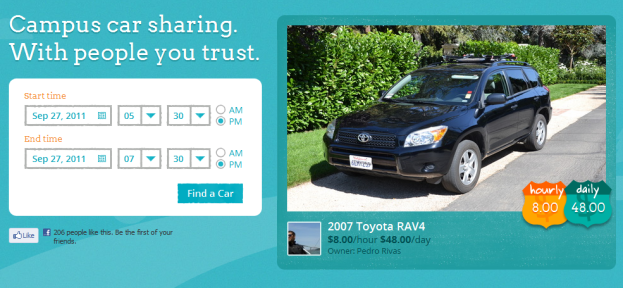 The automotive industry is going through some very public growing pains. People are choosing to share cars, carpool, invest in repairs versus buying new vehicles or just do without a car altogether. And the consumers who are hoofing it most often are college students.
The automotive industry is going through some very public growing pains. People are choosing to share cars, carpool, invest in repairs versus buying new vehicles or just do without a car altogether. And the consumers who are hoofing it most often are college students.
While there are benefits (your health, the savings, and the environment being the obvious few), there always comes a time when you find yourself wishing you had a car—even for just a moment. These moments include but are not limited to when you’re out of bus fare, when your heel breaks, when it’s pouring rain… or maybe when you just get an urge to drive.

“Our mission is to transform the traditional, inefficient model of car ownership. We make it safe, convenient, profitable, and fun for car owners to share their wheels with friends, peers, and colleagues,” says CEO and co-founder Jeff Miller. “We all remember what it’s like to struggle to find a car in college, or to own a car that you can barely afford to maintain. The winning peer-to-peer model must simultaneously meet the needs of car owners and drivers. To date, nobody has mastered this—we see that as our opportunity.”
The stealth startup is announcing its launch today, and Wheelz plans to leverage the lure of the social network platform with its target demographic. The service integrates with Facebook so you can communicate and see your connection with other users. Basically, instead of creating a new social network where you’re not really certain who else is using the site (a la the Airbnb scandal), you’re simply accessing the Facebook network you’ve already created. Not comfortable lending your car to a friend of a friend? That’s your call to make, but you’ll be able to tell at the very least.
And with a team steeped in automotive industry experience (including execs from Mercedes-Benz, Tesla, Google, and Stanford’s Solar Car program), you can be sure this isn’t merely a social experiment.
So how does it work? You must have a Facebook account (and college email address) to sign up, and then your details are checked by the DMV for security purposes. Users can look at the car calculator to find out how much to charge. An iPhone app simplifies the process if you want to book or rent on the go, or you can defer to the website. Wheelz’s insurance policy gives drivers complete coverage during rentals and 24-7 roadside assistance is also included. And if you dread the potentially awkward or inconvenient key-exchange process, Wheelz DriveBox (installed by its team) offers key less entry, via either the iPhone app or a Wheelz card you can swipe.
At the moment Wheelz is launching in for Stanford area only, but keep an eye and ear out for this service to hit your campus in the near future.


